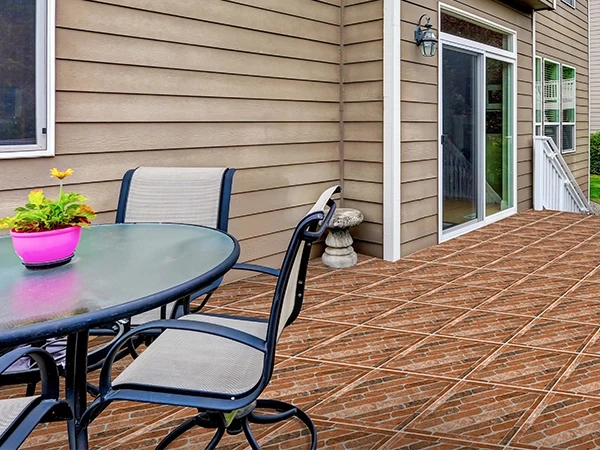When planning an outdoor space—whether it’s a patio, terrace, garden path, or balcony—floor tiles are one of the most important decisions you’ll make. But many homeowners overlook one crucial factor: weather. From harsh sun to heavy rains and cold winters, your local climate plays a big role in how your outdoor floor tiles perform and how long they last.

This guide will help you understand how weather affects tile selection and introduce you to the best types of outdoor tiles for every climate.
☀️ Sun & Heat: Tiles That Stay Cool and Colour-Stable
In regions with strong sunlight and high temperatures, certain tile types can become too hot to walk on and may even fade over time. To prevent that:
- Choose light-coloured tiles that reflect rather than absorb heat.
- Porcelain tiles are excellent for sunny areas because they resist UV rays and don’t lose colour quickly.
- Natural stones like sandstone and slate stay relatively cool but may need sealing to avoid damage.
Avoid dark tiles in open, sun-exposed areas unless you want to add shade or use rugs.
🌧️ Rain & Moisture: Anti-Skid Tiles Are a Must
In rainy climates or during monsoon season, waterlogged tiles can be hazardous. Slippery surfaces are a real concern, especially on patios, entryways, and balconies.
- Look for anti-skid or matte-finish tiles for better grip.
- Textured vitrified tiles offer both style and safety.
- Natural stone tiles with rough finishes (like slate) are also good choices, but they should be sealed to prevent water absorption.
Tiles used in outdoor walkways, garden paths, and open terraces should always be tested for slip resistance.
❄️ Cold & Freeze-Prone Areas: Avoid Cracking Tiles
If you live in a place where winters bring freezing temperatures, the expansion and contraction from frost can cause tile cracking or surface damage.
- Frost-resistant porcelain tiles are your best bet for cold areas.
- Avoid porous materials like untreated ceramic or unsealed natural stone, as they absorb moisture and are prone to cracking.
Proper installation with the right adhesive and spacing is also key to weather resistance in cold climates.
💨 Wind & Dust: Go for Low-Maintenance Finishes
In areas with dry weather or frequent winds, dust and dirt can build up quickly on outdoor surfaces. Choose tiles that are:
- Easy to clean and don’t show stains easily.
- Full-body vitrified tiles are highly durable and don’t chip or scratch easily.
- Avoid overly textured or grooved tiles in dusty zones, as they trap more dirt.
🧱 Common Outdoor Floor Tile Types & Their Uses
Different outdoor spaces have different needs. Here’s a breakdown of popular outdoor tile types:
1. Porcelain Outdoor Tiles
- Durable, non-porous, and weather-resistant
- Great for patios, terraces, and balconies
- Available in natural stone or wood-look finishes
2. Vitrified Tiles
- Hard, dense, and resistant to water and stains
- Ideal for heavy-traffic areas like parking spaces and outdoor seating
3. Natural Stone Tiles (Granite, Slate, Sandstone, etc.)
- Earthy, elegant look
- Ideal for garden paths, porches, and rustic patios
- Require periodic sealing for longevity
4. Ceramic Outdoor Tiles
- Best for covered outdoor areas
- Affordable but more porous—less ideal for extreme climates
🎯 Things to Consider Before Buying Outdoor Tiles
- Check local climate trends (sun exposure, rainfall, frost, etc.)
- Ask for outdoor-grade tiles from your supplier
- Prioritize anti-skid surfaces
- Consider tile thickness and strength, especially in load-bearing areas
🌿 Final Thoughts
Outdoor floor tiles are an investment in both beauty and durability. But what works in one region might not work in another. By understanding your local weather conditions, you can choose tiles that will stand up to the elements and look good for years to come.



